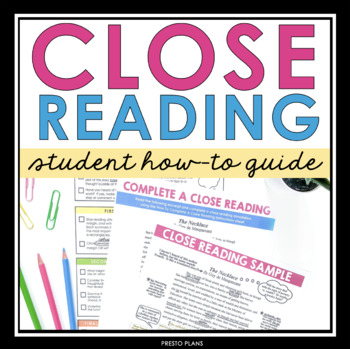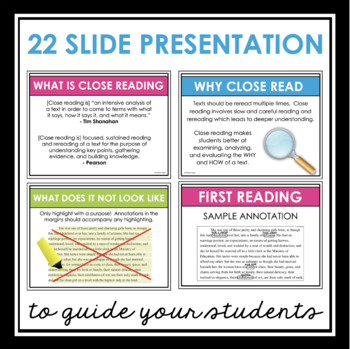Close Reading Annotation Lesson - Presentation & Annotating Passage Assignment
- Zip
What educators are saying
Description
Close Reading Annotation Lesson - Presentation & Annotating Passage Assignment: Help your students understand the process of close reading and annotation of fiction with this ready-to-use resource. Close reading is a skill that does not often come naturally to students, but this presentation, annotating assignment, and handout break down the process in an easy-to-understand way. After introducing this easy-to-use, step-by-step guide, students will have a strong understanding of how to interact with a text to demonstrate understanding, analysis, and evaluation.
Included in this Close Reading and Annotating Resource:
➡️ Teacher Instructions: These step-by-step instructions will guide you on how best to use the resources in this close reading and annotating bundle.
➡️ Close Reading and Annotating Presentation Slides: Use the included 23-slide PowerPoint presentation to guide students through the key steps of a close reading (Before Reading, First Reading, Second Reading, Final Reading). The presentation slides are used in conjunction with a close reading passage assignment that students complete as you model each of the steps.
➡️ Close Reading Passage Assignment: Students will use the blank excerpt from Guy de Maupassant's short story, "The Necklace," to annotate as you share each step in the close reading process. As you guide them through the presentation slides, students will annotate this passage.
➡️ Close Reading and Annotating Steps Handout: This handout outlines the most important information from the presentation and will be a useful guide for students to know the steps of close reading and annotation.
➡️ Completed Close Reading Passage Assignment With Annotations: After students have completed their annotation of "The Necklace," excerpt, share this completed version as a model for what a strong response looks like.
What Teachers Are Saying About This Close Reading and Annotating Resource:
⭐️⭐️⭐️⭐️⭐️ This worked really well to review annotating with my students, as well have a system to use for close reading. My students will be regularly using the close reading steps this year as they navigate texts.
⭐️⭐️⭐️⭐️⭐️ Excellent walk-through of a close read! I love the step-by-step instructions. It made it so much easier for the kids! Thank you!
⭐️⭐️⭐️⭐️⭐️ My students come from a variety of school districts, abilities and backgrounds. This was a great practice activity for them to teach them how to analyze text structure, make notations and actually become involved in the text they read.
Like this resource? You'll love our poetry version!
>>> Poetry Annotation How-To Guide
© Presto Plans
➡️ Want 10 free ELA resources sent to your inbox? Click here!
⭐️ Follow Presto Plans on TpT to see what's new and on sale.





